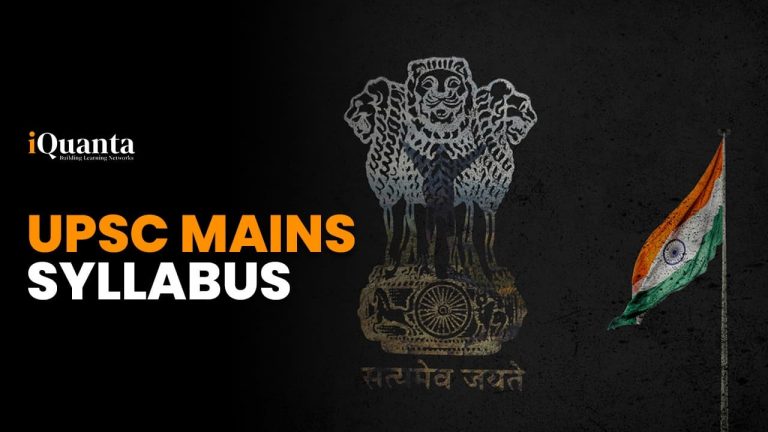
In this article we will learn about the UPSC Mains Syllabus in detail. It’s topics and sub-topics, overview and exam pattern.

UPSC Mains: Overview
Candidates who have successfully cleared the preliminary exams are eligible to appear for the Mains exams. It is crucial for candidates to meet the qualifying criteria for each paper at this stage, as this determines their scores and rankings. The Mains exam evaluates a candidate’s academic knowledge and their ability to articulate their understanding effectively according to the question’s requirements within the specified time limit. Candidates are required to achieve the minimum passing marks in all nine papers of the mains exam. The language papers, namely English and Indian Language papers, serve as qualifying papers, while the remaining papers, including GS-I, GS-II, GS-III, GS-IV, Essay paper, Optional Paper 1, and Paper 2, are graded.
Qualifying Papers
| Paper | Name | Total Marks |
| Paper A | English | 300 Marks |
| Paper B | Any Indian Language | 300 Marks |
Merit Papers
| Paper | Name | Total Marks |
| Paper 1 | Essay Paper | 250 Marks |
| Paper 2 | General Studies I | 250 Marks |
| Paper 3 | General Studies II | 250 Marks |
| Paper 4 | General Studies III | 250 Marks |
| Paper 5 | General Studies IV | 250 Marks |
| Paper 6 | Optional Subject-I | 250 Marks |
| Paper 7 | Optional Subject-II | 250 Marks |
Also Read: UPSC Prelims Syllabus
UPSC Mains: Exam Pattern
Qualifying Papers
In the UPSC Mains Exam, there are 2 language papers: Paper A and Paper B. Candidates are required to choose one language from the options listed in the Eighth Schedule of the Indian Constitution, as displayed in the bullet points below. English serves as the language for the second paper.
Languages to choose from: According to the UPSC Mains Syllabus, candidates can choose one language from the below listed languages.
- Assamese
- Bengali
- Hindi
- Gujrati
- Nepali
- Punjabi
- Sanskrit
- Tamil
- Telugu
- Urdu
- Sindhi
- Odia
- Bodo
- Dogri
- Santali
- Marathi
- Maithili
- Kashmiri
- Manipuri
- Kannada
- Malayalam
- Konkani
Paper A: 300 Marks (Any Indian language should be selected by the candidate)
Paper B: 300 Marks (English)
UPSC Mains Exam Structure: Paper A & Paper B
| Total Marks | 300 Marks each paper |
| Duration | 3 Hours each paper |
| Essay | 100 Marks |
| Reading Comprehension | 60 Marks |
| Grammar | 40 Marks |
| Precis Writing | 60 Marks |
| Translation | (i) English to a compulsory language (20 Marks) (ii) Compulsory language to English (20 Marks) |
| Qualifying Marks | 75 Marks each paper |
Also Read: Best UPSC CSAT Test Series
UPSC Mains Exam Structure: Merit Based Paper
| Paper | Syllabus |
| Essay | No Prescribed Syllabus Provided By UPSC |
| GS-I | (i) Indian Culture (ii) Modern Indian History (iii) History & Geography Of The World |
| GS-II | (i) Indian Constitution (ii) Governance (iii) Polity (iv) International Relations |
| GS-III | (i) Indian Economy (ii) Environment (iii) Science and Technology (iv) Disaster Management (v) Security |
| GS-IV | (i) Ethics and Human Values (ii) Attitude (iii) Aptitude (iv) Ethics In Public Administration (v) Emotional Intelligence |
| Optional Paper- I | One Out of 25 Subjects Has To Be Chosen |
| Optional Paper- II | One Out of 25 Subjects Has To Be Chosen |
Optional Subjects To Choose From
Each candidate must select a single optional subject from a pool of 25 choices mentioned in the UPSC Mains Syllabus. This subject will entail two papers, with a cumulative weightage of 500 marks. The process of choosing the most suitable optional subject for the UPSC mains demands careful deliberation. To make an informed decision, please consult the provided list to determine which optional subject aligns best with your strengths and interests.
- Geography
- Sociology
- Commerce & Accountancy
- Economics
- Agriculture
- Animal Husbandry & Veterinary Science
- Chemistry
- History
- Law
- Botany
- Electrical Engineering
- Management
- Mathematics
- Zoology
- Physics
- Philosophy
- Mechanical Engineering
- Statistics
- Public Administration
- Medical Science
- Geology
- Psychology
- Political Science & International Relations
- Anthropology
- Civil Engineering
Conclusion
The Mains examination accounts for a total of 1750 marks, calculated from seven papers each worth 250 marks. This detailed article on the UPSC Mains Syllabus must have given you a fair idea as to what one can expect in the examination. Successful candidates proceed to the interview stage, known as the UPSC Personality Test. The candidates’ scores in the interview, totaling 275 marks, are then added to their marks from the UPSC mains. This combined score forms the final merit list of recommended candidates.
Join iQuanta’s dedicated UPSC Facebook group to get latest updates, daily quiz and be a part of the winning clan.
Mastering CSAT requires dedication, perseverance, and a strategic approach. With the right preparation and mindset, aspirants can overcome this hindrance and move forward in their journey towards serving the nation through the civil services. Check out iQuanta CSAT Course 2024
